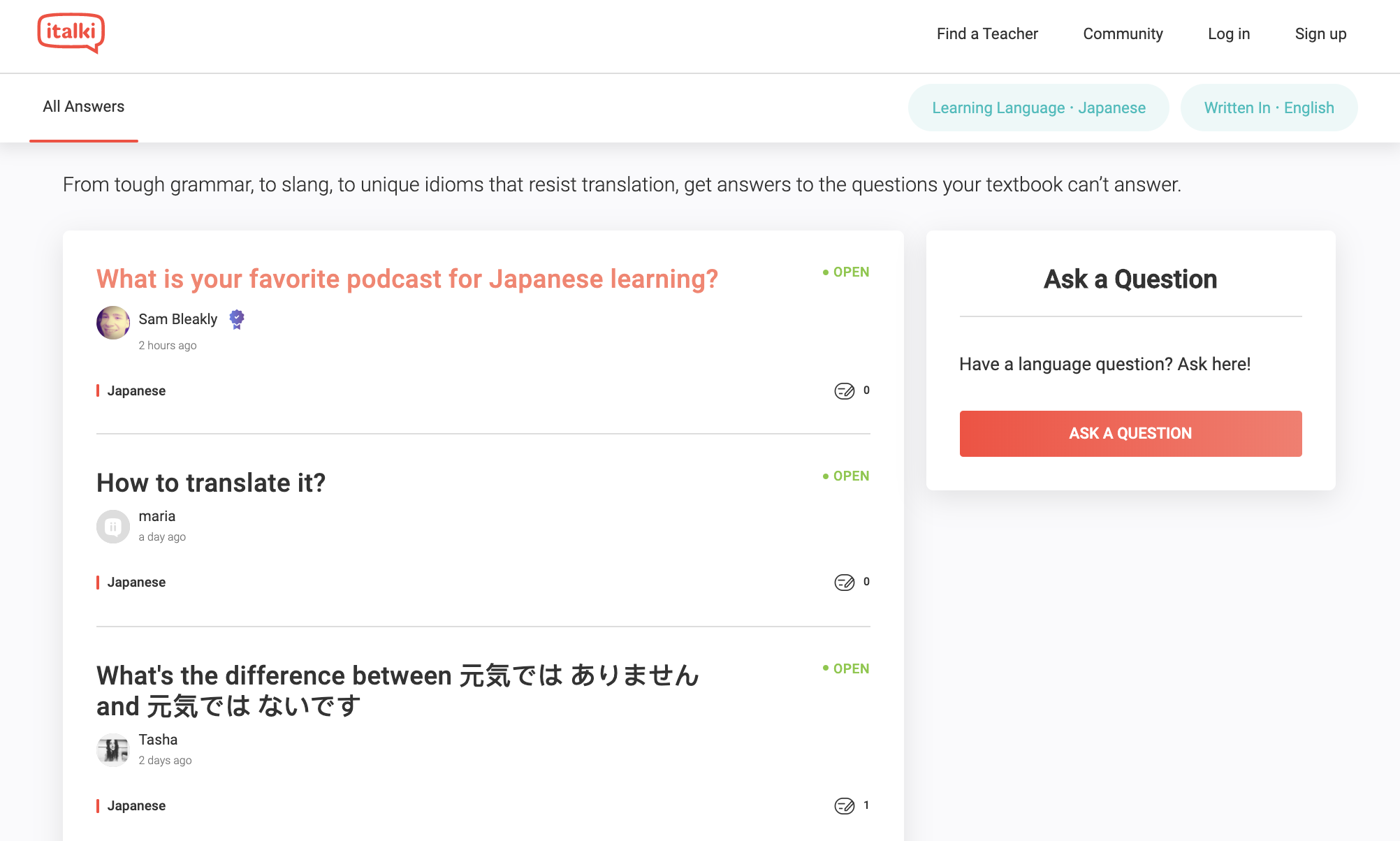日本のトイレを使ったことがありますか?使ったことがないなら、きっとそれに驚かれると思います。日本では何十年も前からビデが人気です。そしてそれは今や世界中で急速に普及しはじめています。欧米では、トイレにボタンがないのが普通なので、日本で初めてトイレに行くと興味深く感じます。日本のトイレには数多くのボタンがあり、その機能の違いに驚かされます。
このハイテクなトイレ設備は、トイレを使用したあとデリケートゾーンを洗浄するためのもので、トイレ体験をアップグレードしたい人には必需品となるような色々な機能が付いています。では、日本のビデは何がそんなに特別なのでしょうか?
この究極のガイドブックでは、日本のビデの世界を深く掘り下げ、その仕組みやメリット、そしてなぜそれがあなたの生活に必要なのかを探っていきます。日本で最も人気のあるトイレの機種ごとに、知っておくべき重要な情報をまとめてみました。次にあなたが自然の呼びかけに応じてトイレに行くとき、もう各ボタンの使い方に困ることはないでしょう。
日本のビデの仕組み
海外のトイレはウォシュレットやスプレー式が多いですが、日本のトイレのようなものはありません。もちろん、日本のウォシュレットは通常のスプレーで水を流して洗浄します。通常のトイレに取り付けられており、また衛生的で快適に使用できるよう、さまざまな機能が付いています。
最もベーシックな日本式のビデは、水を肌に吹きかけるだけですが、より進化したモデルでは、シートヒーターや空気乾燥機、脱臭機まで付いています。中には、音楽プレーヤーやLEDライトを内蔵し、スパのような体験を演出するモデルもあるぐらいです。
日本のビデで使用されるお湯は一般的に温水で、通常のものより快適です。また、水温や水圧、スプレーのパターンを調節できるモデルもあり、自分好みにカスタマイズもできます。また、多くの日本製ウォシュレットはセルフクリーニング構造で、使用するたびにノズルを清潔に保つことができます!
概して、日本のビデは、従来のトイレットペーパーよりも徹底して衛生的な洗浄体験ができるよう設計されています。また、トイレットペーパーの使用量を減らせるので、環境にも優しいのです。
日本のビデの歴史
ビデの歴史は古く、最初の電子ビデは1960年代に日本で発明されました。初期のモデルはシンプルで、基本的なスプレーシステムでした。しかし、技術が進歩するにつれ、ビデも進歩し、1980年代に入ると、日本企業はビデにシートヒーターや送風乾燥機などの機能を追加し始めました。
今日、日本のビデは世界で最も先進的なものとなっています。2016年現在、日本の家庭の81%がウォシュレットと呼ばれるビデを使用しています。ウォシュレットは基本的に、日本のトイレのトップメーカーであるTOTOのブランド名です。ウォシュレットは、衛生的で快適に使用できる様々な機能がついています。日本のウォシュレットメーカーは、ウォシュレットをより良いものにするため、常に新しい機能や技術を追加し、製品を改良しています。

トイレボタンの意味
日本の電子ウォシュレットの代表的なモデルであるウォシュレットを初めて使うとき、便器の側面や、便器側の壁に取り付けられているたくさんのボタンがついた操作パッドでしくじってしまうかもしれません。
ボタンのラベルはほとんど英語ですが、それでも各機能が何をするのか混乱するかもしれません。以下に、各ボタンの機能を紹介していきます。
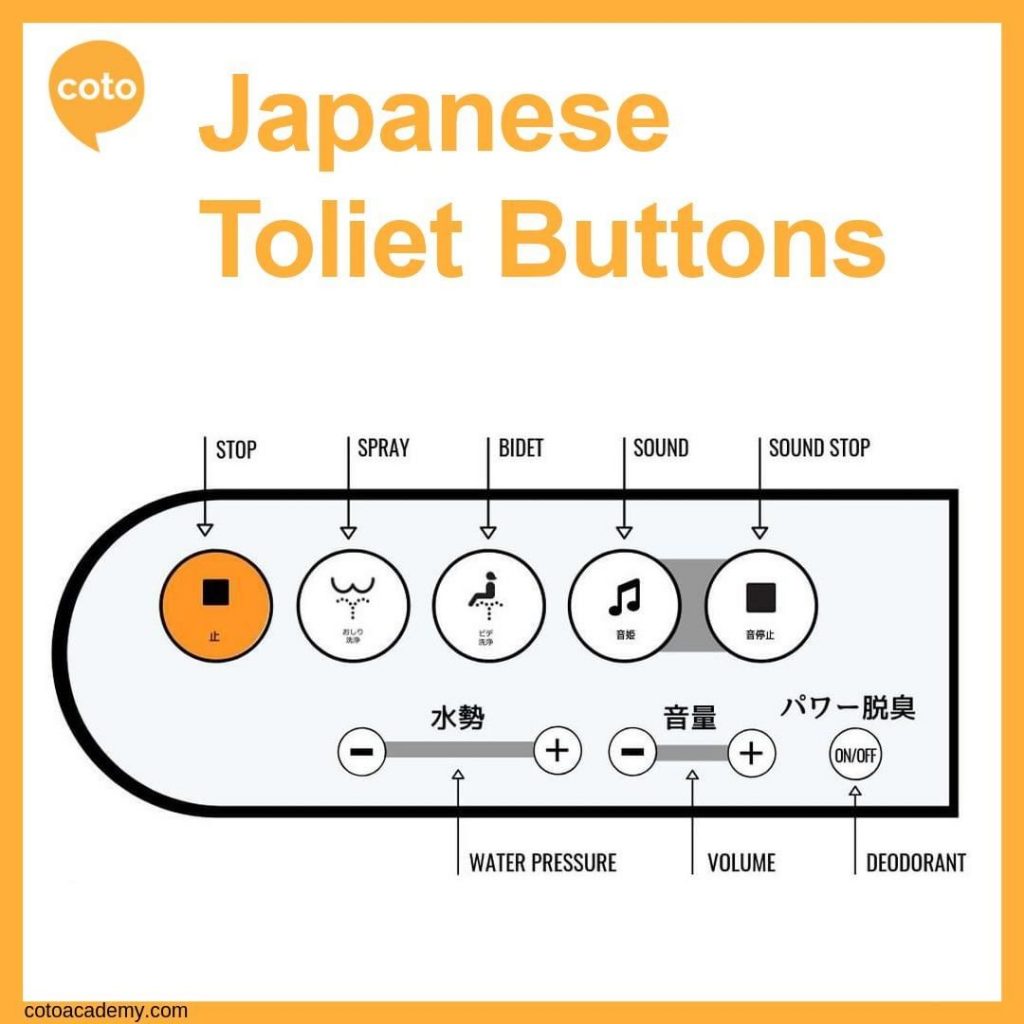
| Buttons | Romaji | English | Function |
|---|---|---|---|
| 止 | tome | stop | used to stop the water spray from either the oshiri or bide |
| おしり | oshiri | rear | used to spray water for rear washing |
| ビデ | bide | bidet | used to spray water for front washing |
| 音/音姫 | oto/otohime | sound | Press this to turn on the water sound stimulator to make yourself more discrete |
| 音停止 | ototeishi | stop sound | Press this to stop the sound. |
| 水勢 | suisei | water pressure | This controls the water pressure for your spray. |
| 音量 | onryou | sound volume | This controls the volume when you have the sound stimulator on. |
| パワー脱臭 | pawaadasshu | deodorant | Deodorizer filters out all unpleasant smells. |
上記のラベルとボタンは、標準的なトイレに見られるいちばん標準のものです。他のモデルで見られるクールな機能やバリエーションもいくつか紹介します!
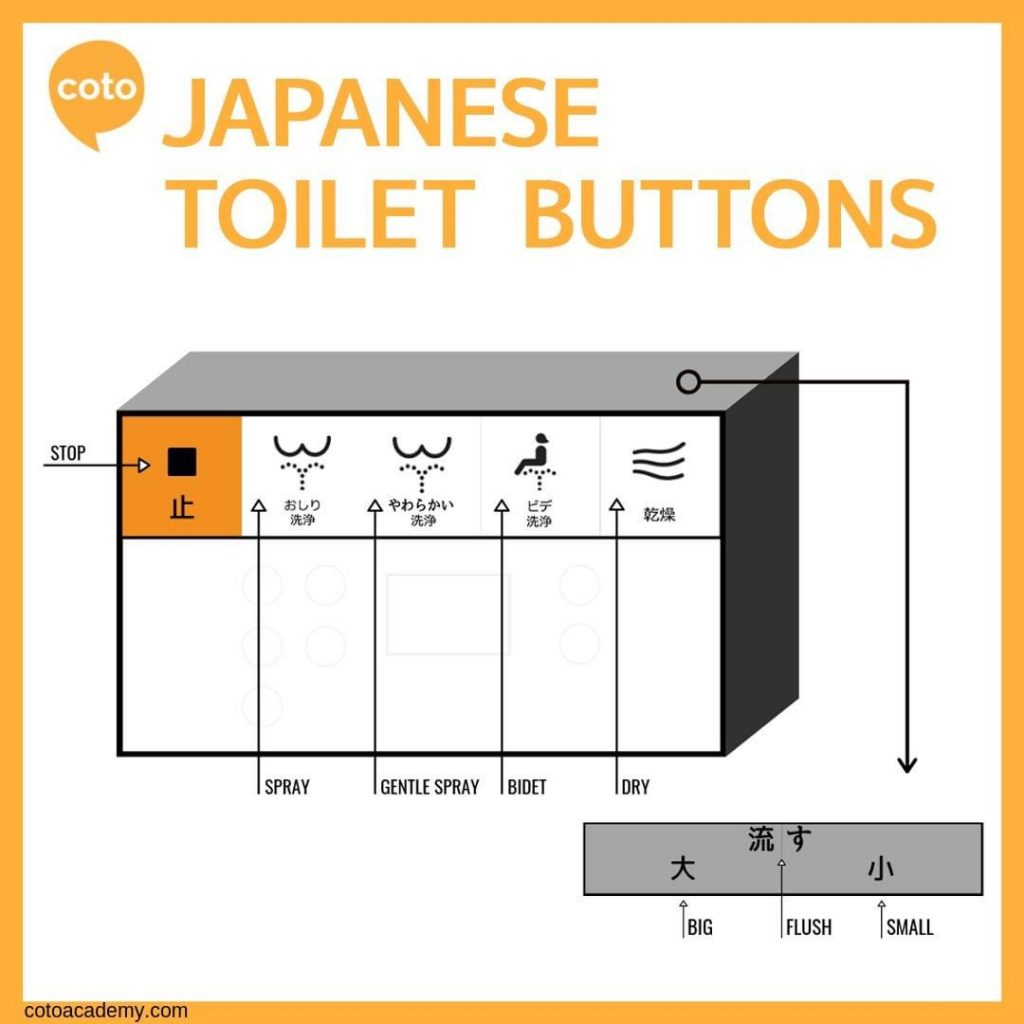
| Label | Romaji | English | Function |
|---|---|---|---|
| 乾燥 | Kansou | Dry | Use this to dry your rear or front after washing. |
| 入/切 | Iri/setsu | On/off | |
| 弱 | Yowai | Weak | Use to set the pressure of the water (weak) |
| 強 | Tsuyoi | Strong | Use to set the pressure of the water (strong) |
| 洗浄位置 | Senjou ichi | Nozzle position | Use this to adjust the nozzle position |
| 前 | Mae | Front | (For adjusting nozzle position) |
| 後 | Ato | Back | (For adjusting nozzle position) |
| 温度設定 | Ondo settei | temperature setting | This is used to set the temperature of the toilet seat |
| 便座 | Benza | Toilet seat | |
| 温水 | Onsui | Warm water | |
| 流す | Nagasu | Flush | Flush the toilet |
| 大 | Oo | Big | |
| 小 | Ko | Small |
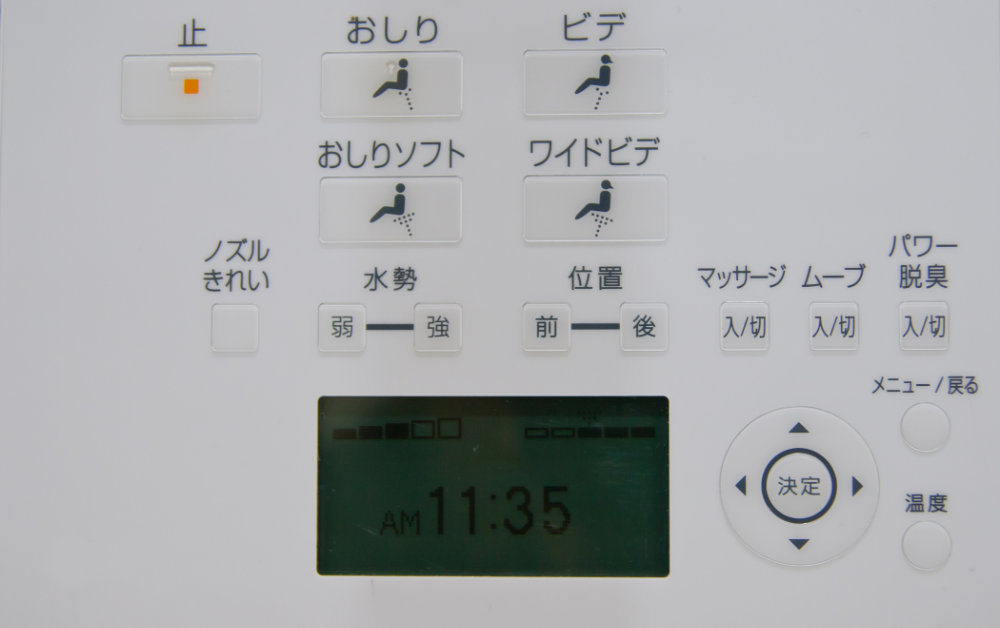
スマートなトイレの使い方
各ボタンの機能を理解すれば、使い方は簡単です。ここで注意すべき点をいくつか挙げてみます:
1. 自動センサー
日本の多くのトイレ、特に新しいトイレには、様々な機能の自動センサーがついています。例えば、誰かが個室に入ると、ボタンを押さなくてもサウンド・シミュレーターが作動することがあります。サウンドシュミレーターは壁に取り付けられていることが多いので、通常の水洗ボタンと間違えないように注意してください。さらに、最近のトイレの中には、便座から離れると同時に自動的に流れるものもあります。また新しい機種でも人感センサーが付いているので、トイレに入るとふたが自動的に上がりますが、驚かないでくださいね。
2. 緊急コールボタン
トイレの中には、通常、洗浄ボタンの隣に緊急呼び出しボタンが設置されているものがあります。このボタンは、体の不自由な人やトイレの使用中に急病になった場合に使用するためのものです。「呼出」と表示されており、緊急時のみ使用できます。赤や黄色に着色されていることが多いので、多くの人が水洗ボタンと間違える可能性もあるでしょう。
3. 洗浄ボタンの位置
トイレのモデルによって、洗浄ボタンはタンクの側面にあったり、押しボタンやモーションコントロールセンサーにあったり、壁に取り付けられたメインコントロールボックスに組み込まれていたりします。ウォーターシュミレーターの音や緊急通報ボタンと間違えないように注意してください。水洗ボタンを識別するために、 流す、大、小などのラベルを探してください。
4. トイレットペーパーを流す
日本では、使用後のトイレットペーパーをそのままトイレに捨てる習慣があります。ただし、ペーパータオルやティッシュは紙詰まりの原因になることがあるので、トイレットペーパーは必ず取り付けてあるものを使用することが大切です。生理用ナプキンや包み紙などのその他のものは、個室内の小さなゴミ箱に捨ててください。
これらのガイドラインに従うことで、日本のスマートトイレを自信を持って効果的に使うことができます。
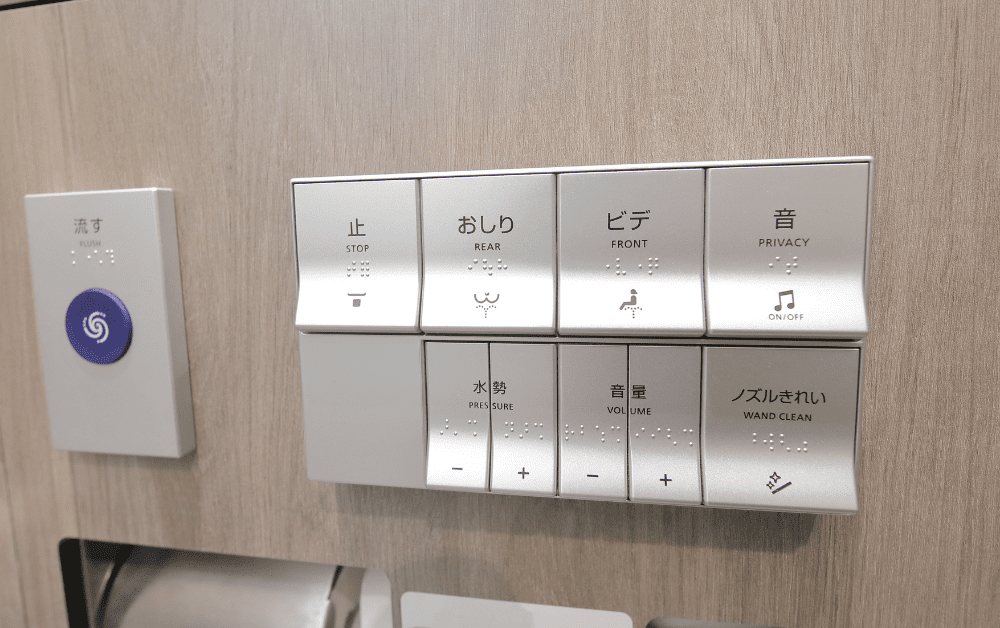
洋式トイレと和式トイレ
日本のウォシュレットは、トイレットペーパーを使って排泄後の陰部を洗浄する伝統的な洋式トイレとよく比較されます。どちらの方法も洗浄効果はあるが、ビデには従来の洋式トイレにはない利点がいくつもあります。
ビデはトイレットペーパーよりも完璧に衛生的な洗浄ができます。水を使って陰部を洗浄するため、乾いたトイレットペーパーよりもバクテリアやその他の有害物質を取り除くのに効果的です。
また、ビデはトイレットペーパーの使用量を減らすことができるため、環境にも優しいです。これは環境に良いだけでなく、長い目で見ればお金の節約にもなります。
最後に、ビデは従来の洋式トイレよりも快適に使用できるといっていいでしょう。ウォシュレットには暖房便座が付いており、寒い冬には特に効果的を発揮します。機種によっては、空気乾燥機や脱臭機まで付いていて、より快適なトイレ体験ができます。
日本に長く住んでいる外国人でさえ、トイレットペーパーだけのトイレには戻れないと言うほどです!
結論
もちろん、スマートな日本のトイレを試すためだけに日本に来る人はいないでしょうが、ここでしか体験できないことのひとつであることは間違いありません!
このハイテクトイレは、伝統的な西洋のトイレよりも徹底して衛生的な洗浄体験を提供し、快適で使いやすい様々な機能を備えています。
また、快適で使いやすい様々な機能が搭載されていますので、このトイレを使うと、自分のトイレをアップグレードしたくなるかもしれません。
その他の日本シリーズガイド
- Guide to you Japanese Washing Machines
- Guide to Your Japanese Rice Cookers
- Guide to Your Japanese Food Labels
- Guide to your Japanese Bathtubs
日本語学習にご興味のある方は、下記のフォームにご記入の上、当校の詳細をご覧ください。
日本のビデは使いにくい?
いいえ、日本のビデはとても使いやすいのです。直感的な操作で自分好みにカスタマイズできる。
日本のウォシュレットは高い?
日本製ビデの価格は、搭載されている機能や技術によって異なる。しかし、市場には手頃な価格のものがたくさんあります。
日本のビデは大量の水を使うのですか?
日本のビデは、最小限の水量でデリケートゾーンを洗浄する。トイレットペーパーを大量に使う伝統的な欧米のトイレよりも、実は環境に優しいのだ。
日本のビデは衛生的か?
そう、日本のビデは衛生的な洗浄を提供するために設計されている。水を使ってデリケートゾーンを洗浄するため、乾いたトイレットペーパーよりもバクテリアやその他の有害物質を取り除くのに効果的なのだ。


